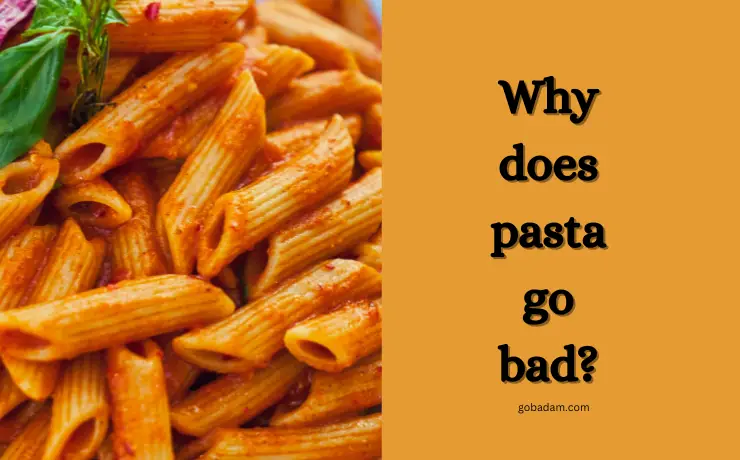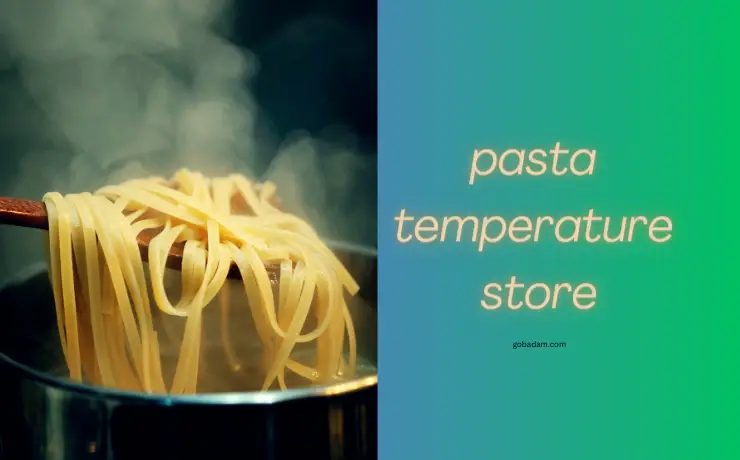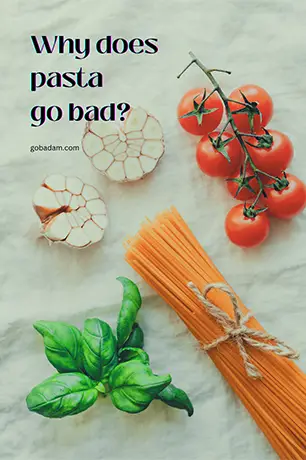Why does pasta go bad? Pastas can go bad for many reasons. The effect of the environment, internal and external factors, expiry date, and many other things can cause the deterioration of pasta.
SEE OFFER 👉🏻 Pasta products list
Let’s detail the factors affecting the deterioration of pasta, why the pasta may be spoiled according to its current condition, the measures that can be taken to extend the life of the pasta, and more.
Why does pasta go bad?
Pasta, a beloved staple in countless culinary traditions, boasts a commendable shelf life when subjected to appropriate storage practices. This remarkable longevity is primarily attributed to its unique composition, characterized by a trifecta of factors: low moisture content and the utilization of durum wheat.
Nevertheless, even this seemingly resilient carbohydrate can succumb to the passage of time and the influence of diverse variables, leading to its gradual deterioration and eventual spoilage. Here are the most significant things for why does pasta goes bad.

Moisture and Humidity
The precarious relationship between pasta and moisture becomes evident when faced with elevated levels of humidity. In such conditions, pasta’s inherent propensity to absorb moisture comes into play, triggering a cascade of undesirable consequences. As water infiltrates the pasta’s structure, it becomes a breeding ground for mold growth, giving rise to the unappetizing prospect of spoilage.
Oxygen Exposure
The subtle interplay between pasta and oxygen unveils yet another vulnerability. As the steady march of time progresses, the oils present within the pasta can fall prey to the effects of oxygen exposure. The insidious result is the onset of rancidity, accompanied by a transformative shift in both flavor profile and texture, leaving behind a dish far removed from its original delightful character.
SEE OFFER 👉🏻pasta storage containers
Insects and Pests
Pasta, despite its dry and seemingly impervious nature, remains susceptible to the tenacious advances of insects and pests. These microscopic invaders, notably weevils and their kin perceive the dormant pasta as an alluring feast. To thwart their efforts, the vigilance of proper storage in an air-tight, fortified enclosure is paramount, safeguarding the pasta’s integrity against these miniature culinary marauders.
Temperature
The dual nature of temperature becomes evident as pasta is exposed to the extremities of heat and cold. The ramifications are significant, often manifesting in the form of transformative alterations in both taste and texture. Exposure to excessive heat can lead to the impairment of pasta’s inherent flavors and the establishment of conditions conducive to spoilage. Conversely, the icy grip of severe cold can compromise the pasta’s structural integrity, resulting in an unappetizing mushiness.

Quality of Ingredients
The foundations of pasta’s longevity lie, in part, in the quality of the durum wheat used in its creation. The distinction between higher-quality and lesser-quality wheat becomes manifest in the endurance of the pasta. Superior wheat imparts a longer shelf life, bestowing upon the pasta the capacity to withstand the relentless march of time.
SEE OFFER 👉🏻organic spaghetti pasta
Storage Conditions
A fundamental tenet of preserving pasta’s cherished qualities resides in meticulous storage practices. The cornerstone of these practices entails housing pasta in a sanctuary of cool, arid conditions, encapsulated within an impenetrable airtight sanctuary. This strategic approach minimizes exposure to not only moisture but also the encroachments of contaminants that might otherwise compromise its essence.
SEE OFFER 👉🏻Airtight Food Storage Containers

Expiration Dates
Embedded within the pasta’s packaging, a tangible chronicle of its optimal period awaits discovery in the form of a “best by” or “use by” date. Although pasta, in its dried state, evades the traditional notion of expiration, this date serves as a beacon, signifying the zenith of its flavor and quality. Yet, it’s imperative to note that surpassing this threshold doesn’t necessarily render the pasta unsafe to consume; rather, its luster might dim while still maintaining an acceptable level of edibility.
Ultimately, as the sands of time trickle down, pasta’s resilience gradually gives way to the inevitability of aging. Nevertheless, the journey from freshness to deterioration rarely bestows acute health risks upon those who dare to partake beyond its prime.
As long as no telltale signs of decay—mold, odors, or other palpable discomforts—make their presence known, the consumption of aged pasta remains a benign endeavor. Yet, prudence guides us to honor the principle of timely utilization and diligent storage, fostering the longevity of pasta’s exquisite taste and texture.
So, let’s discover how to store pasta from different aspects.
How to prolong pasta shelf life?
First of all, let’s look at what we can do with the unopened packages in order to extend the life of the pasta. After that, let’s talk about how to preserve opened and cooked pasta.
How to preserve pasta? (How long can pasta be stored?)
It is easy to extend the shelf life of unopened pasta packages, contrary to popular belief. Let’s look at some key points to consider.
👉🏻Ensure that the packaging is not damaged.
👉🏻Keep in dry and cool places.
👉🏻Keep them in the dark. Do not expose it to direct sunlight.
👉🏻Avoid storing in places where there is a possibility of infestation.
👉🏻You can keep them in the fridge in very hot weather.
👉🏻Rotate your pasta stock: It always works. The oldest pasta comes first.
As for the opened and cooked pasta…
How do you preserve cooked pasta?
Preserving cooked pasta requires careful handling and storage to prevent it from becoming mushy or losing its flavor. Here’s how to preserve cooked pasta:
Cool Quickly: After cooking, immediately drain the pasta and rinse it with cold water to stop the cooking process and remove excess starch. This helps prevent overcooking and sticking.
Drain Thoroughly: Ensure the pasta is well-drained to remove excess water. Shake the colander gently to eliminate as much moisture as possible.
Portion: Divide the cooked pasta into portion sizes that you’re likely to use in one sitting. This reduces the need to reheat and re-cool the pasta multiple times, which can affect its texture.
Toss with Oil: Lightly toss the cooled pasta with a bit of olive oil or cooking spray. This helps prevent sticking and keeps the pasta separated.
Airtight Containers: Place the pasta in airtight containers. Make sure the containers are properly sealed to prevent air from reaching the pasta.
Refrigerate: Store the containers in the refrigerator. Cooked pasta can be refrigerated for up to 3-5 days. Ensure that the refrigerator is set to 40°F (4°C) or below to maintain food safety.
Avoid Overcooking: When reheating, avoid overcooking the pasta. Heat it only until it’s warmed through. Overheating can make the pasta excessively soft.
Sauce Separately: If you plan to serve the pasta with sauce, consider storing the sauce separately. Reheat the pasta and sauce separately, then combine them before serving.
Use Microwave or Stovetop: To reheat, you can use the microwave or stovetop. In the microwave, place the pasta in a microwave-safe container with a bit of water or sauce to prevent drying out. Stir occasionally during reheating. On the stovetop, use a pot with a bit of water or sauce, and heat gently while stirring.
Freshen Up: If the reheated pasta seems a bit dry, you can add a small amount of water, broth, or sauce to restore moisture.
Serve Immediately: Once reheated, serve the pasta promptly to enjoy it at its best texture and flavor.
Remember that while these steps can help preserve the quality of cooked pasta, reheated pasta may not have the exact same texture as freshly cooked pasta. It’s always best to cook only the amount of pasta you intend to consume to ensure the best culinary experience.
How to preserve pasta in the fridge?
To preserve pasta in the fridge effectively, ensure it cools quickly after cooking by rinsing it with cold water. Toss the cooled pasta with a light coating of oil to prevent sticking, and divide it into portioned servings. Place the portions in airtight containers, label them with the cooking date, and refrigerate promptly within two hours of cooking. This method helps maintain the pasta’s texture, prevents spoilage, and allows you to enjoy it at its best quality within 3-5 days.

How to store pasta with sauce?
Storing pasta with sauce requires attention to detail for maintaining both texture and flavor. Firstly, ensure that the cooked pasta is properly drained and cooled to prevent overcooking and sticking. Toss the cooled pasta lightly with oil to create a barrier against sauce absorption. If the sauce has been previously cooked, cool it before combining it with the pasta to prevent heat-induced sogginess.
SEE OFFER 👉🏻 Velveeta shells and cheese
Next, mix the pasta and sauce in a suitable ratio, considering that pasta tends to absorb moisture over time. Portion the combined pasta and sauce into meal-sized servings to reduce reheating and potential quality loss. Transfer the portions into airtight containers, making sure they’re well-sealed to prevent air exposure and moisture absorption.
Label the containers with the preparation date to monitor freshness. Refrigerate the pasta with sauce promptly and place it on the middle or upper shelves of the refrigerator for consistent temperatures. Reheat portions gently using methods like microwave or stovetop, and serve immediately to savor the desired texture and taste. Consuming pasta with sauce within 3-5 days ensures the best eating experience.

Frequently Asked Questions About Why Does Pasta Go Bad
Here are the top-asked questions that I’ve received about why does pasta go bad. If you have any questions or comments, please feel free to share them!
How do I store pasta for the long term?
To store pasta for the long term, follow these steps:
Choose dried pasta varieties.
Use airtight containers to seal out air and moisture.
Portion the pasta and remove excess air before sealing.
Label and date containers.
Store in a cool, dry place away from heat and moisture.
Inspect periodically for signs of issues.
Consider oxygen absorbers for extra protection.
Following these guidelines will help maintain the quality and edibility of your stored pasta over an extended period.
How can I store opened pasta?
Keep away from humidity, air, heat, and sun. You can store it without removing it from the package, by latching the package or putting it in airtight boxes. This way, you minimize staleness. Purchase airtight pasta containers.
Does fresh pasta go bad?
Yes, fresh pasta can go bad. Due to its higher moisture content compared to dried pasta, fresh pasta is more susceptible to bacterial growth and mold formation. If not stored properly in the refrigerator, it can develop an off smell, unusual texture, or visible mold growth, indicating spoilage.
You may also enjoy learning about 👇🏻👇🏻👇🏻
👉🏻 Does Turkish coffee expire?
👉🏻 Do Capers Go Bad?


